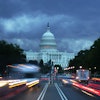Emerging Issues

The challenges communities will grapple with in the future don’t typically overlap with the challenges they face right now. The world needs someone who’s looking around the corner to recognize, examine, and evaluate tomorrow’s solutions—today.
In recognition of World Quantum Day, the U.S. Chamber of Commerce Foundation, in partnership with the Boston Consulting Group, shares a high-level summary of significant findings from a war game conducted with U.S. public and private sector leaders.
Programs
Through our incubator pilots, we source, vet, and nurture cutting-edge solutions for the problems of tomorrow.
Working in concert with other Foundation programs and business partners, we develop theories of change and test new approaches to challenges across a spectrum of disciplines, including geopolitical risk, democracy and capitalism, and business-led solutions to wicked problems.
Latest Content
Peer feedback is important, especially for our AI-powered colleagues. We had AI chatbots evaluate each other's responses to determine the capabilities and creative limits of the four most popular AI chatbots. By having the tools assess each other, we uncovered strengths, limits, and insights into their 'personalities,' biases, and self-awareness.
Meet Moon Nguyen and Melissa Mendizabal, the U.S. Chamber Foundation’s first Innovation Scholars.
The American Communities Project, based at Michigan State University, is a three-year effort to study the nation's fraying political, cultural, and socioeconomic fabric.
Innovation is at the core of the U.S. Chamber Foundation’s mission. In honor of Innovation Day on February 16th, Kelsey Margey, manager of strategy and innovation, shares a summary of the corporate trends shaping the landscape in 2024.
The world is facing a "polycrisis" of interconnected challenges, including economic instability, geopolitical tensions, and extreme weather.
American companies constitute unparalleled strategic assets. Through pioneering R&D and commercialization, the genius of U.S. enterprise drives global innovation. Strength abroad requires nurturing strength at home. Policymakers must recognize business of all sizes as fundamental to national security and, according to Edelman’s Trust Barometer, stewards of public trust.
As the world pivots towards a future that demands adaptability and diverse skill sets, the U.S. Chamber Foundation’s annual Talent Forward summit emerges as a cornerstone event that embodies the pursuit of a more prepared, agile, and prosperous workforce.
U.S. Chamber of Commerce Foundation President Carolyn Cawley issued the following statement today on the release of the 2022 NAEP U.S. history and civics results, also known as the Nation's Report Card.







